Learn how to can tomatoes safely and easily with step-by-step directions. If you have an abundance of homegrown tomatoes, it’s a great way to enjoy the essence of summer all year long!
We’ll be covering canning tomatoes in a water bath canner using any of the following methods:
- Whole or halved tomatoes packed in water (raw pack and hot pack)
- Whole or halved tomatoes packed in tomato juice (raw pack and hot pack)
- Whole or halved tomatoes packed raw without added liquid
- Crushed tomatoes with no added liquid
Jump to Section
What are the best tomatoes for canning?
You can choose any variety of tomatoes for water bath canning, just be sure to select only ones that are disease-free, firm, and preferably vine-ripened.
Do not can damaged tomatoes or those from dead or frost-killed vines. They may contain harmful pathogens.

How many tomatoes do I need?
You will need about 21 pounds of tomatoes to can 7 quarts. Each quart takes about 3 pounds.
Do Tomatoes Need to Be Canned with Added Acid?
Tomatoes are comparatively low in acidity, and so acid must be added for safe canning. Add acid directly to the jars when filling with tomatoes.
Bottled lemon juice is the recommended ingredient to ensure a safe, consistent acidity. Use 2 tablespoons per quart or 1 tablespoon per pint. Why bottled lemon juice? Fresh lemon juice can vary in acidity so it’s not recommended.
Citric acid can be used instead of bottled lemon juice. Use ½ teaspoon per quart or ¼ teaspoon per pint. However, its flavor may be more pronounced than that of lemon juice.
Four tablespoons of a 5 percent acidity vinegar per quart (2 tablespoons per pint) may be used instead of lemon juice or citric acid. However, vinegar may cause undesirable flavor changes.
You can add sugar to offset acid taste, if desired.
Do I have to add salt when canning tomatoes?
Adding salt is purely optional and is not necessary for safe canning. You can, however, add salt to taste to the jars (about a teaspoon per jar). If you do use salt, use pickling or canning salt which is pure salt with no additives rather than regular table salt.
Equipment for Canning Tomatoes
- Water Bath Canner - A water bath canner is a big pot with a rack inside. A 21.5-quart pot holds 7-quart size jars. If you don’t have a water bath canner, you can use a large stock pot with a rack on the bottom to prevent the jars from touching the bottom of the pan.
- Wide Funnel - a wide funnel allows you to get the tomatoes into the jar while keeping the rim of the jar clean. If the rim is not very clean, the lids may not form a tight seal.
- Glass canning jars - When selecting your canning jars, ensure they are specifically designed for canning and are free of any cracks or imperfections, including in the rim. Inspect the mason jars carefully and discard any damaged ones.
- Canning lids and bands - Canning lids are essential to ensure a proper seal, preserving the freshness and safety of your canned tomatoes. Prior to using the canning lids, wash them in hot, soapy water, and rinse thoroughly. It is recommended to use new lids each time you can, as they may not provide a proper seal if reused. Bands are used to secure the lids in place during canning and can be reused as long as they are not damaged.
- Jar lifter - A jar lifter helps you to safely remove the hot jars from the pan.
- Damp cloth - to wipe jar rims
Hot Packing vs Raw Packing (Cold Pack)
Before jars and cans can be processed, they have to be filled through either the raw (cold) pack or hot pack method.
Raw (Cold) Packing
According to the USDA, Raw-packing is the practice of filling jars tightly with freshly prepared, but unheated food. Such foods, especially fruit, will float in the jars. The entrapped air in and around the food may cause discoloration within 2 to 3 months of storage. Raw-packing is more suitable for vegetables processed in a pressure canner.
Hot Packing
Hot-packing is the practice of heating freshly prepared food to boiling, simmering it 2 to 5 minutes, and promptly filling jars loosely with the boiled food.
Whether food has been hot-packed or raw-packed, the juice, syrup, or water to be added to the foods should also be heated to boiling before adding it to the jars. This practice helps to remove air from food tissues, shrinks food, helps keep the food from floating in the jars, increases vacuum in sealed jars, and improves shelf life. Preshrinking food permits filling more food into each jar.
Hot-packing is the best way to remove air and is the preferred pack style for foods processed in a boiling-water canner. At first, the color of hot-packed foods may appear no better than that of raw-packed foods, but within a short storage period, both color and flavor of hot-packed foods will be superior.
How to Can Tomatoes
Step 1: Wash the jars, however it is NOT necessary to sterilize them
According to the National Center for Home Food Preservation, it is NOT necessary to sterilize the jars before canning if the processing time is 10 minutes or more. It doesn't hurt your product to do it anyway, but it does require additional time and energy and is unnecessary.
You should always clean jars just prior to filling them when canning. Wash jars in a dishwasher or by hand, using detergent and rinsing well. Clean jars should then be kept warm prior to filling. You can leave them in the closed dishwasher after the cycle, or use your canner as it is preheating, or create a separate water bath in a large pot of water that will keep the jars both clean and warm.
Step 2: Begin preheating water in the canner
Bring water to a simmer in either the canner or in a separate pan.
Step 3: Wash the Tomatoes
Before canning, wash the tomatoes thoroughly in order to remove any dirt, debris, or chemicals that might be present on the skin. Rinse the tomatoes under cold water while gently rubbing the surface.
Step 4: Remove the Tomato Skins
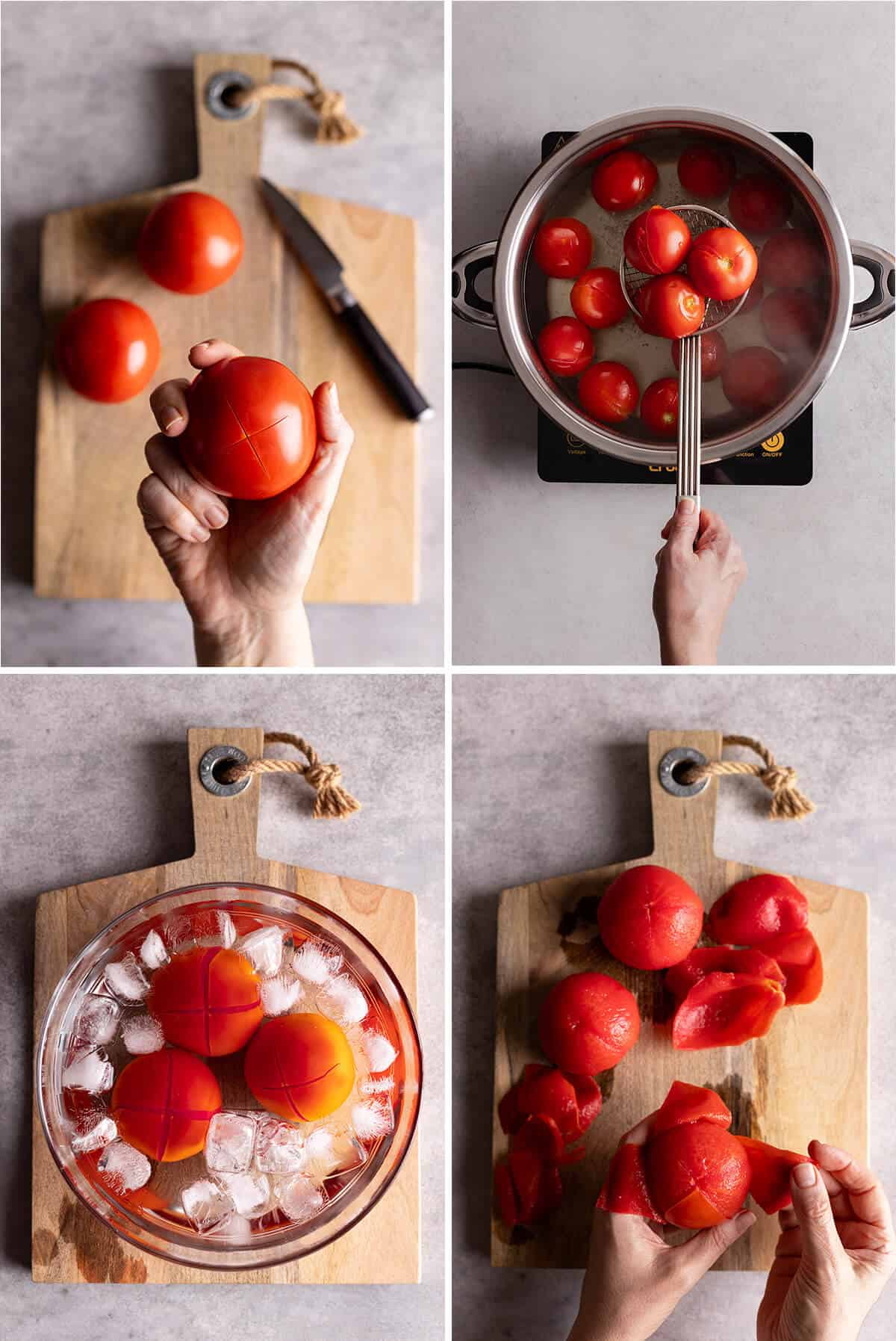
To peel the tomatoes, follow these easy steps:
- Bring a pot of water to a rolling boil.
- Cut an “X” in the bottom of each tomato, just deep enough to penetrate the skin.
- Prepare a bowl of water with ice.
- Dip the tomatoes in the boiling water for about 60 seconds until the skins split.
- Immediately transfer the tomatoes to a bowl of cold water to prevent overcooking.
- Once the tomatoes are cool enough to handle, slip off the skins
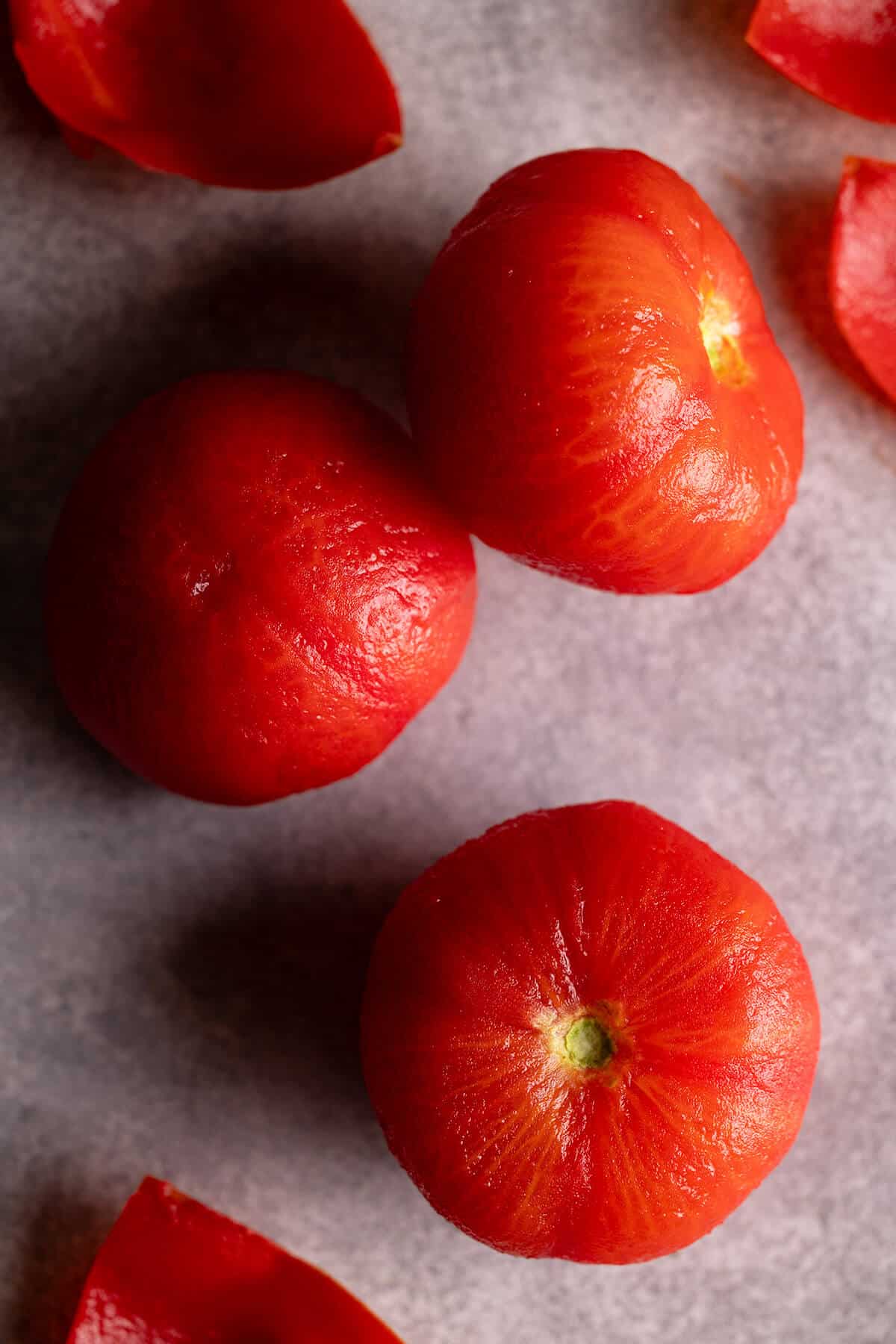
Step 5: Packing the Tomatoes and Processing Times
You can pack the tomatoes in any of the following methods:
Whole or halved tomatoes packed in water - raw pack or hot pack
- Leave tomatoes whole or halve them
- Add bottled lemon juice or citric acid to jars (can be added before or after tomatoes)
- Add 1 teaspoon of salt per quart to the jars, if desired
- Raw pack -- Heat water, for packing tomatoes, to boiling. Fill hot jars with prepared raw tomatoes, leaving ½-inch headspace. Cover tomatoes in the jars with boiling water, leaving ½-inch headspace.
- Hot pack -- Put prepared tomatoes in a large saucepan and add enough water to completely cover them. Boil tomatoes gently for 5 minutes. Fill hot jars with hot tomatoes leaving ½-inch headspace. Add cooking liquid to the jars to cover the tomatoes, leaving ½-inch headspace.
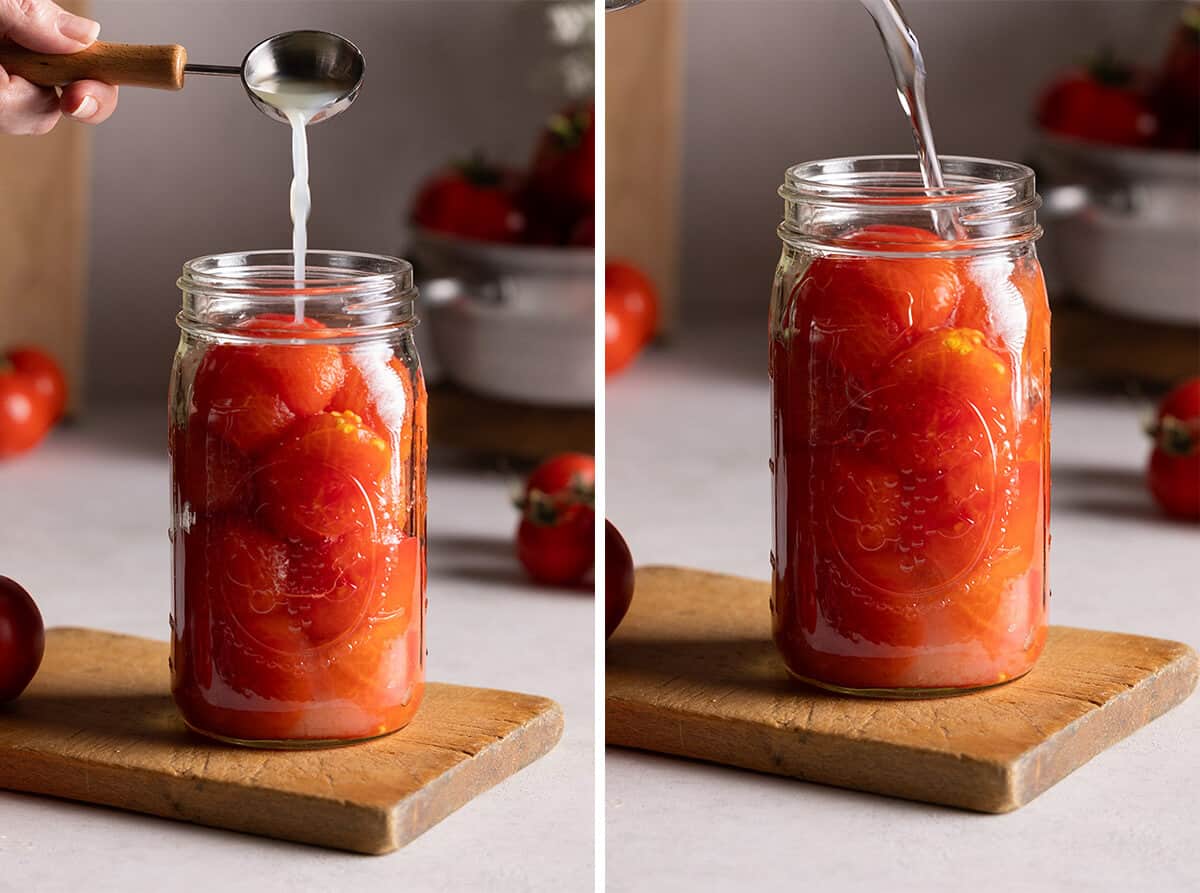

Whole or halved tomatoes packed in tomato juice - raw pack or hot pack
- Leave tomatoes whole or halve them
- Add bottled lemon juice or citric acid to jars (can be added before or after tomatoes)
- Add 1 teaspoon of salt per quart to the jars, if desired
- Raw pack – Heat tomato juice in a saucepan. Fill jars with raw tomatoes, leaving ½-inch headspace. Cover tomatoes in the jars with hot tomato juice, leaving ½-inch headspace.
- Hot pack – Put tomatoes in a large saucepan and add enough tomato juice to completely cover them. Boil tomatoes and juice gently for 5 minutes. Fill jars with hot tomatoes, leaving ½-inch headspace. Add hot tomato juice to the jars to cover the tomatoes, leaving ½-inch headspace.

Whole or halved tomatoes packed raw without added liquid
- Leave tomatoes whole or halve them
- Add bottled lemon juice or citric acid to jars (can be added before or after tomatoes)
- Add 1 teaspoon of salt per quart to the jars, if desired
- Fill jars with raw tomatoes, leaving ½-inch headspace. Press tomatoes in the jars until spaces between them fill with juice. Leave ½-inch headspace.

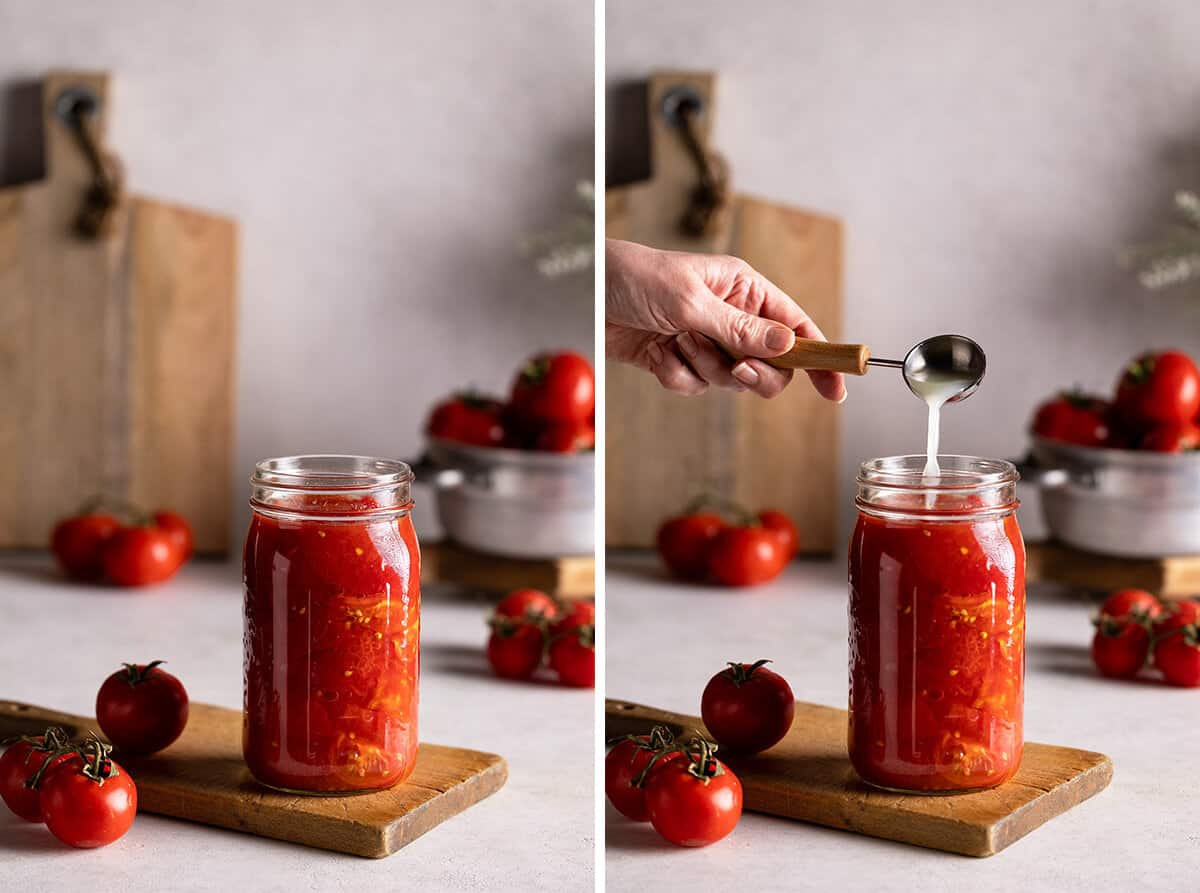
Crushed tomatoes with no added liquid
- Remove cores and quarter
- Heat one-sixth of the quarters quickly in a large pot, crushing them with a wooden mallet or spoon as they are added to the pot. This will exude juice. Continue heating the tomatoes, stirring to prevent burning. Once the tomatoes are boiling, gradually add remaining quartered tomatoes, stirring constantly These remaining tomatoes do not need to be crushed. They will soften with heating and stirring. Continue until all tomatoes are added. Then boil gently 5 minutes.
- Add bottled lemon juice or citric acid to jars
- Add 1 teaspoon of salt per quart to the jars, if desired
- Fill jars immediately with hot tomatoes, leaving ½-inch headspace.

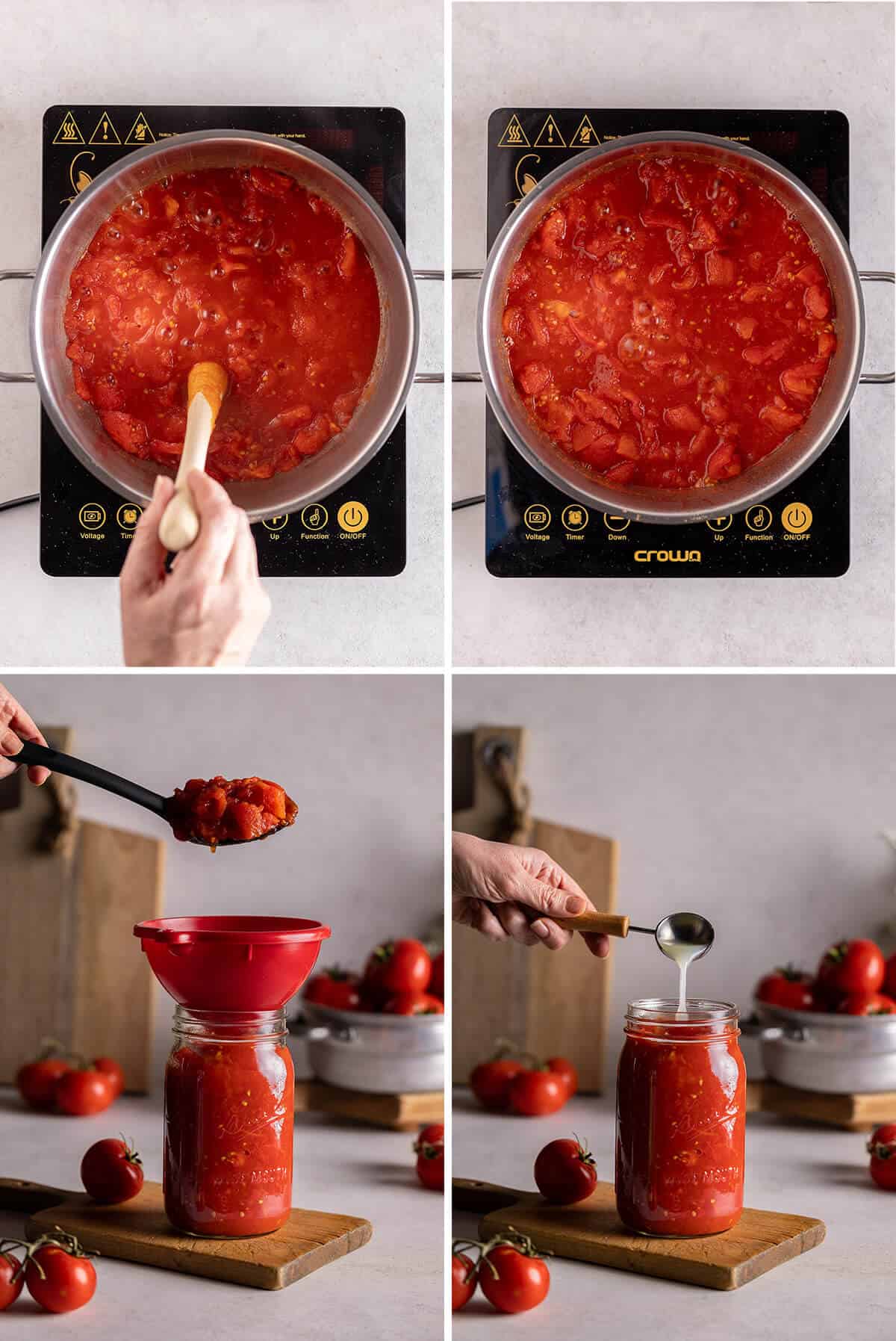
Step 6: Seal the jars
- Insert a clean table knife or chopstick into a jar and run it around the perimeter to dislodge any air bubbles. Add a bit more tomato if necessary to maintain ½ inch of headroom.
- Use a cloth and wipe the rims of the jars, being sure they are clean and dry. Remove any tomato residue that may be there. If there is even a slight bit of tomato juice on the rim, the lids may not seal properly.
- Set the lids on the jars and screw on the rings, screwing until just finger-tight, tightening them gently but securely with the tips of your fingers, not forcefully with your entire hand.
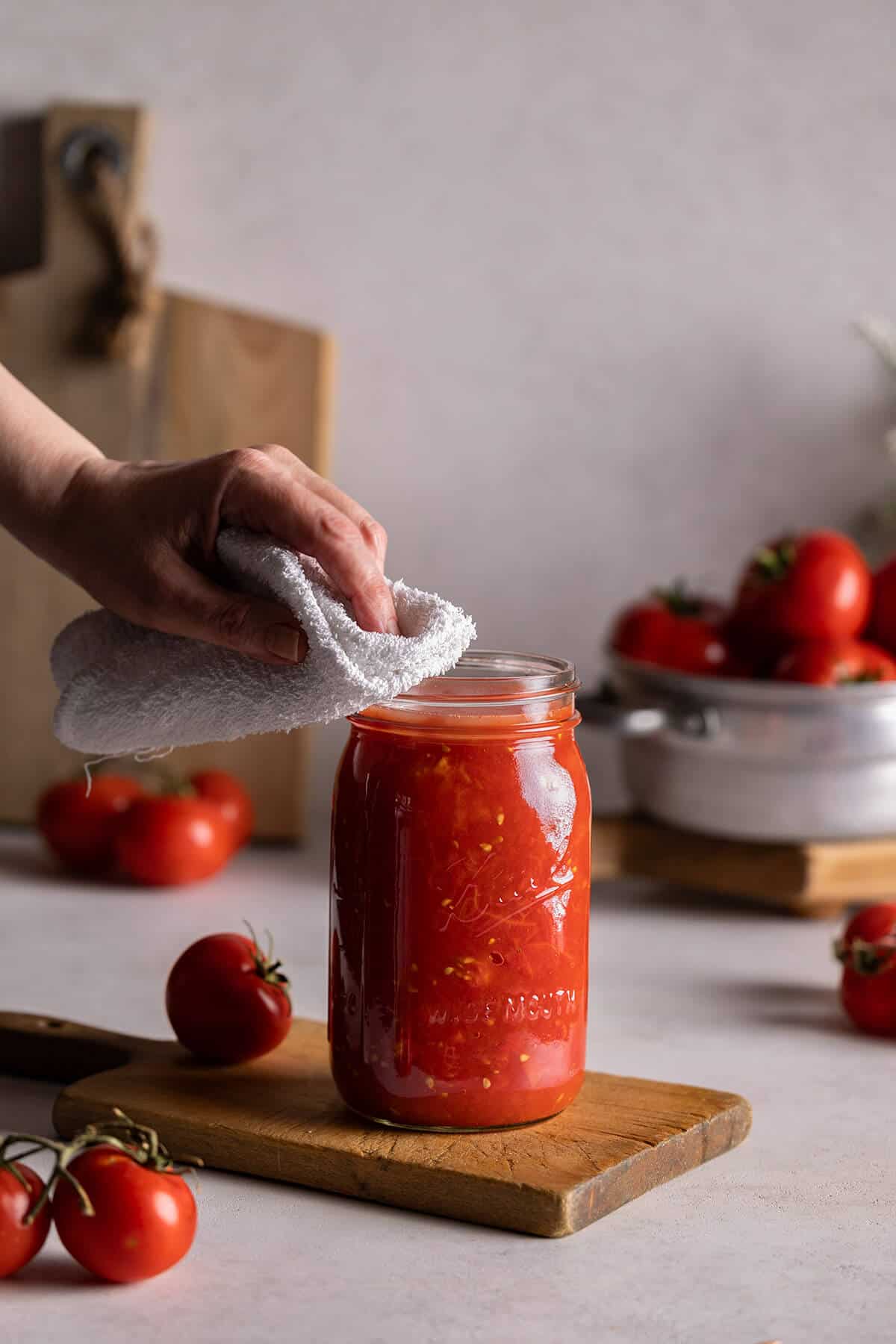
Step 7: Process the tomatoes
- Lower the jars into the hot water in the canner, making sure that they don’t touch. Add more hot water to cover the jars by at least 1 inch.
- Boil the jars. Bring to a gentle boil; adjust the heat and process the jars for the time indicated on the chart. The water MUST cover the jars and MUST continue boiling at all times. (I keep another pan of water simmering on the stove for this.) If the water stops boiling, the timing has to start over again once it comes back to a boil.
- Cool the jars. Turn off the heat and let the jars sit in the water for 5 minutes. Transfer the jars with a jar lifter to a kitchen towel or rack set over a kitchen towel and cool completely, about 12-24 hours.
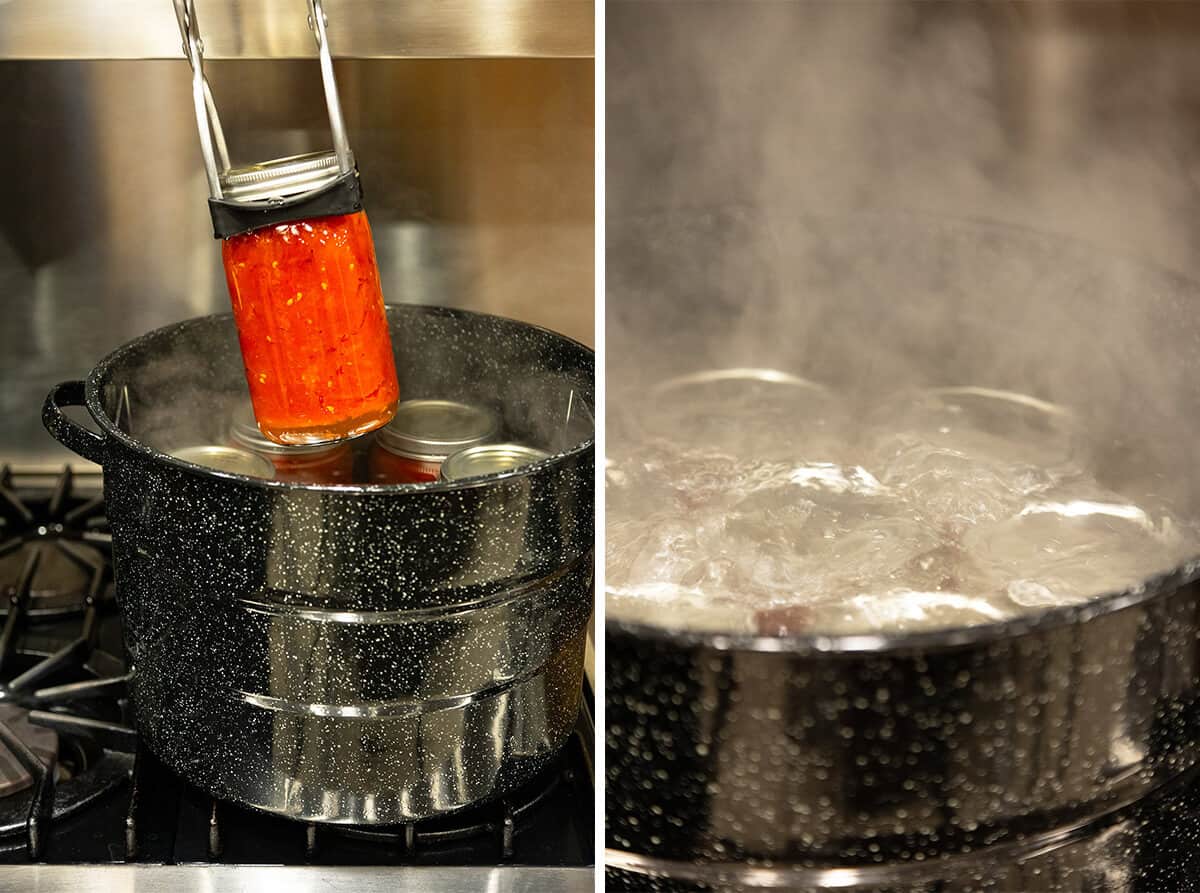
Step 8: Test the Jar Seals
It's important to double-check the seals once your jars have cooled. If your jars aren't completely sealed, they won't be safe to eat later.
After cooling jars for 12 to 24 hours, remove the screw bands and test seals with one of the following options:
- Option 1. Press the middle of the lid with a finger or thumb. If the lid springs up when you release your finger, the lid is unsealed.
- Option 2. Tap the lid with the bottom of a teaspoon. If it makes a dull sound, the lid is not sealed. If food is in contact with the underside of the lid, it will also cause a dull sound. If the jar is sealed correctly, it will make a ringing, high-pitched sound.
- Option 3. Hold the jar at eye level and look across the lid. The lid should be concave (curved down slightly in the center). If center of the lid is either flat or bulging, it may not be sealed.
Unsealed jars should be stored in the refrigerator and used within three days, or you can reprocess the tomatoes within 24 hours.

Step 9: Label
Remove bands and wash outside of jars in warm soapy water. Dry jars and label each jar with contents and date.
Storing Canned Tomatoes
When storing your canned tomato jars, consider the following:
- Choose a cool, dark, and dry storage area away from direct sunlight, as it can affect the quality and shelf life of the canned tomatoes.
- Keep the jars away from heat sources like stoves, ovens, or heating vents.
- Store jars on sturdy shelves or in cabinets, preferably in a single layer, so you can easily access and monitor them.
- Maintain a temperature of 50°F to 70°F (10°C to 21°C) for optimal shelf life.
By following these guidelines, you can ensure your canned tomatoes remain delicious and safe to eat for 12 to 18 months.
Ensuring safe canned foods
The growth of the bacterium Clostridium botulinum in canned food may cause botulism—a deadly form of food poisoning. The most important way of avoiding botulism is following the prescribed methods of canning and using the recommended processing times.
Identifying and handling spoiled canned food
IF IN DOUBT, THROW IT OUT!
Do not taste food from a jar with an unsealed lid or food that shows signs of spoilage. You can more easily detect some types of spoilage in jars stored without screw bands. Growth of spoilage bacteria and yeast produces gas which pressurizes the food, swells lids, and breaks jar seals. As each stored jar is selected for use, examine its lid for tightness and vacuum. Lids with concave centers have good seals.
Next, while holding the jar upright at eye level, rotate the jar and examine its outside surface for streaks of dried food originating at the top of the jar. Look at the contents for rising air bubbles and unnatural color.
While opening the jar, smell for unnatural odors and look for spurting liquid and cotton-like mold growth (white, blue, black, or green) on the top food surface and underside of lid.
Spoiled low-acid foods, including tomatoes, may exhibit different kinds of spoilage evidence or very little evidence. Therefore, all suspect containers of spoiled low-acid foods, including tomatoes, should be treated as having produced botulinum toxin and handled carefully.
Frequently Asked Questions
Which tomato varieties are best for canning?
Several tomato varieties are suitable for canning, including Roma, San Marzano, and Amish Paste. These varieties have firm flesh, fewer seeds, and lower water content, making them ideal for preserving. It's essential to select ripe, unblemished tomatoes for best results in canning.
How is citric acid used when canning tomatoes?
Citric acid is used to increase the acidity of canned tomatoes, ensuring their safety during storage. When canning tomatoes in quart jars, add ½ teaspoon of citric acid crystals or 2 tablespoons of bottled lemon juice to each jar before filling with the tomato product. For pint jars, use half these amounts. Acidification is crucial regardless of the canning method used—water bath or pressure canning—to prevent the growth of harmful bacteria.
Should I use wide-mouth or regular canning jars?
You can use either size. I prefer wide-mouth jars because they’re easier to get my hand inside them for cleaning. Also, if you’re canning whole tomatoes, wide-mouth jars may make it easier to get the tomatoes in.
Is it necessary to sterilize jars before canning?
Jars do not need to be sterilized before canning if they will be filled with food and processed in a boiling water bath canner for 10 minutes or more.
Do I really need to leave a certain amount of headspace in the jar?
Yes. Leaving the specified amount of headspace in a jar is important to assure a vacuum seal. If too little headspace is allowed, the food may expand and bubble out when air is being forced out from under the lid during processing. The bubbling food may leave a deposit on the rim of the jar or the seal of the lid and prevent the jar from sealing properly. If too much headspace is allowed, the food at the top is likely to discolor. Also, the jar may not seal properly because there will not be enough processing time to drive all the air out of the jar.
Can two layers of jars be processed in a canner at one time?
Yes. Two layers can be processed at one time. Place a small wire rack between the layers so water will circulate around each jar. Make certain the water covers the tops of all jars by 1 inch in a boiling water bath canner.
Is it okay to reuse jar fittings (lids and bands)?
Lids should not be used a second time since the sealing compound becomes indented by the first use, preventing another airtight seal. Screw bands may be reused unless they are badly rusted or the top edge is pried up, which would prevent a proper seal.
What causes jars to break in a canner?
Breakage can occur for several reasons, including using commercial food jars rather than jars manufactured for home canning, using jars that have hairline cracks, putting jars directly on the bottom of the canner instead of on a rack, putting hot food in cold jars or putting jars of raw or unheated food directly into boiling water in the canner, rather than into hot water. This causes a sudden change in temperature, which is too wide a margin between the temperature of filled jars and water in the canner before processing.
How do I know if my canned tomatoes are safe to eat?
If the lid becomes unsealed or if the contents become cloudy, bubbly, moldy or develop an off smell, discard all contents and do not eat.
How to use canned tomatoes
You can use canned tomatoes in recipes calling for cans of diced, crushed, or stewed tomatoes. Here are some of my favorites:
- Lasagna
- Spaghetti and Meatballs
- Hungarian Goulash
- Chili
- Harira (Moroccan Lamb and Legume Soup)
- Tomato Mascarpone Pasta

How to Can Tomatoes: Step-by-Step Guide for Preservation
- Total Time: 1 hour 5 minutes
- Yield: 1 quart
Description
Learn how to can tomatoes safely and easily with step-by-step directions. If you have an abundance of homegrown tomatoes, it’s a great way to enjoy the essence of summer all year long!
Ingredients
· 3 pounds tomatoes (approximately, per quart)
· 2 Tablespoons Lemon Juice (per quart)
· Optional: ½-1 teaspoon salt (per quart)
Instructions
For canning whole or halved tomatoes (hot pack method):
1. Begin by filling the canner halfway with water and preheating
2. Blanch and peel the tomatoes
3. Leave tomatoes whole or halve them
4. Put prepared tomatoes in a large saucepan and add just enough water to cover them. Boil tomatoes gently for 5 minutes.
5. Add bottled lemon juice or citric acid to jars
6. Add ½ - 1 teaspoon of salt per quart to the jars, if desired
7. Fill jars with tomatoes leaving ½-inch headspace. Add cooking liquid to the jars to cover the tomatoes, leaving ½-inch headspace.
8. Remove air bubbles by running a plastic knife around inside of jar
9. Wipe rim of jars clean. Put on the lids and screw on the bands
10. Place jars in canner and add additional water to cover the jars by 1-2 inches.
11. Cover the pot and bring to a boil.
12. Process the tomatoes for 45 minutes for quarts, adding additional time for your altitude (see below). Start timing once it begins boiling.
13. Transfer the jars with the tongs to a kitchen towel or rack and cool completely, about 12-24 hours.
14. After cooling, check the lids for a proper seal. Press the middle of the lid with a finger or thumb. If the lid springs up when you release your finger, the lid is unsealed.
15. Label the jars with contents and date. Tomatoes keep their optimum quality for 1 year.
Notes
*If canning pints, use 1 tablespoon bottled lemon juice
*Citric acid may be used instead of bottled lemon juice. Use ½ teaspoon per quart or ¼ teaspoon per pint
If you are at a higher altitude, increase the processing time by the following amounts:
For whole or halved tomatoes packed in water - raw pack:
· Leave tomatoes whole or halve them
· Add bottled lemon juice or citric acid to jars
· Add 1 teaspoon of salt per quart to the jars, if desired
· Heat water, for packing tomatoes, to boiling. Fill hot jars with prepared raw tomatoes, leaving ½-inch headspace. Cover tomatoes in the jars with boiling water, leaving ½-inch headspace.
For whole or halved tomatoes packed in tomato juice - raw pack or hot pack:
· Leave tomatoes whole or halve them
· Add bottled lemon juice or citric acid to jars
· Add 1 teaspoon of salt per quart to the jars, if desired
· Raw pack – Heat tomato juice in a saucepan. Fill jars with raw tomatoes, leaving ½-inch headspace. Cover tomatoes in the jars with hot tomato juice, leaving ½-inch headspace.
· Hot pack – Put tomatoes in a large saucepan and add enough tomato juice to completely cover them. Boil tomatoes and juice gently for 5 minutes. Fill jars with hot tomatoes, leaving ½-inch headspace. Add hot tomato juice to the jars to cover the tomatoes, leaving ½-inch headspace.
For whole or halved tomatoes packed raw without added liquid:
· Leave tomatoes whole or halve them
· Add bottled lemon juice or citric acid to jars
· Add 1 teaspoon of salt per quart to the jars, if desired
· Fill jars with raw tomatoes, leaving ½-inch headspace. Press tomatoes in the jars until spaces between them fill with juice. Leave ½-inch headspace.
For crushed tomatoes with no added liquid:
· Remove cores and quarter
· Heat one-sixth of the quarters quickly in a large pot, crushing them with a wooden mallet or spoon as they are added to the pot. This will exude juice. Continue heating the tomatoes, stirring to prevent burning. Once the tomatoes are boiling, gradually add remaining quartered tomatoes, stirring constantly These remaining tomatoes do not need to be crushed. They will soften with heating and stirring. Continue until all tomatoes are added. Then boil gently 5 minutes.
· Add bottled lemon juice or citric acid to jars
· Add 1 teaspoon of salt per quart to the jars, if desired
· Fill jars immediately with hot tomatoes, leaving ½-inch headspace.
- Prep Time: 20
- Cook Time: 45
- Category: uncategorized
- Method: canning
- Cuisine: American
Nutrition
- Serving Size: 4 oz
- Calories: 31
- Sugar: 4.5 g
- Sodium: 8.5 mg
- Fat: 0.3 g
- Carbohydrates: 6.6 g
- Protein: 1.5 g
- Cholesterol: 0 mg
For more information, refer to the USDA Complete Guide to Home Canning









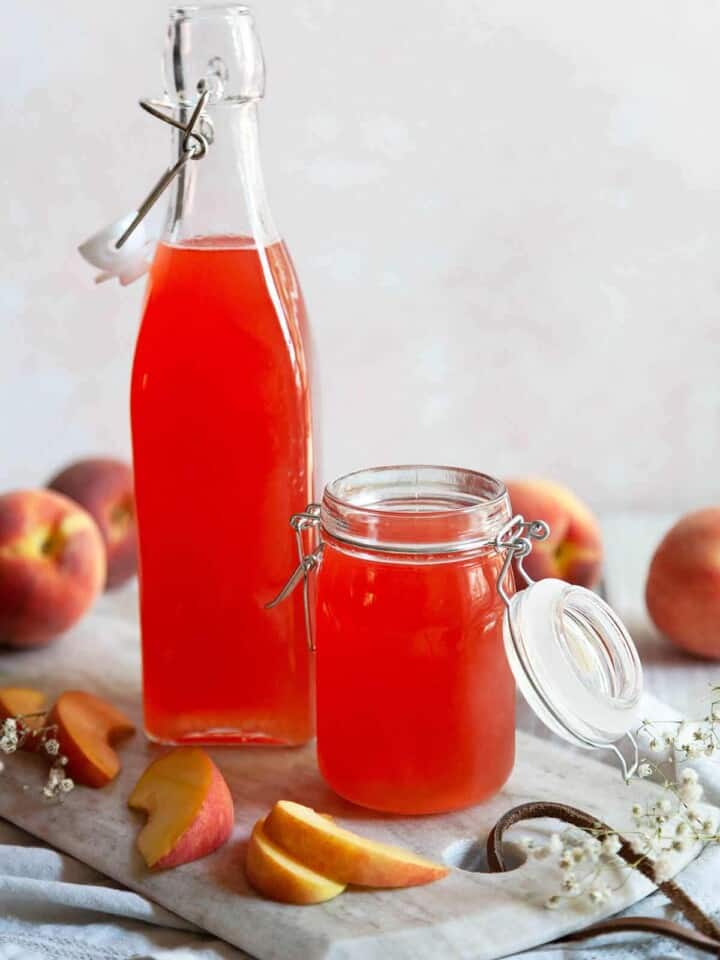
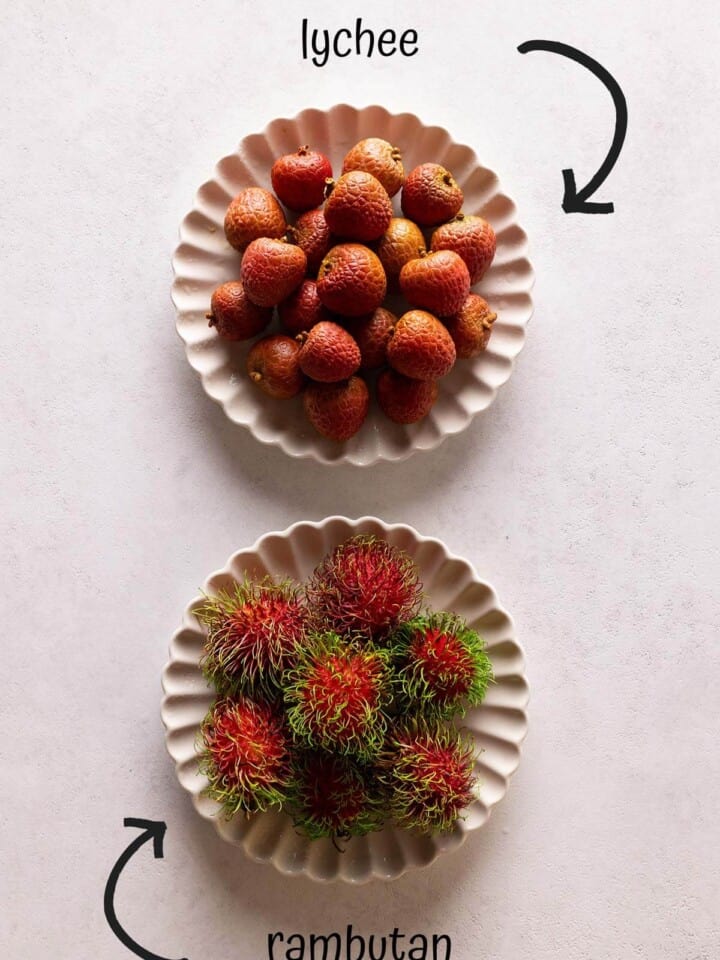

Karen (Back Road Journal)
Great tutorial for anyone wanting to can tomatoes. Oh to have an abundance of tomatoes again.
Kelly
Thanks Karen!
2pots2cook
This post is definitely worth of saving for everybody, beginners and experienced chefs. Simple, homemade canning is the best to enjoy summer abundance during cold days. Five stars it is Kelly! Thank you so much for sharing your version!
Kelly
Thanks so much, Davorka!